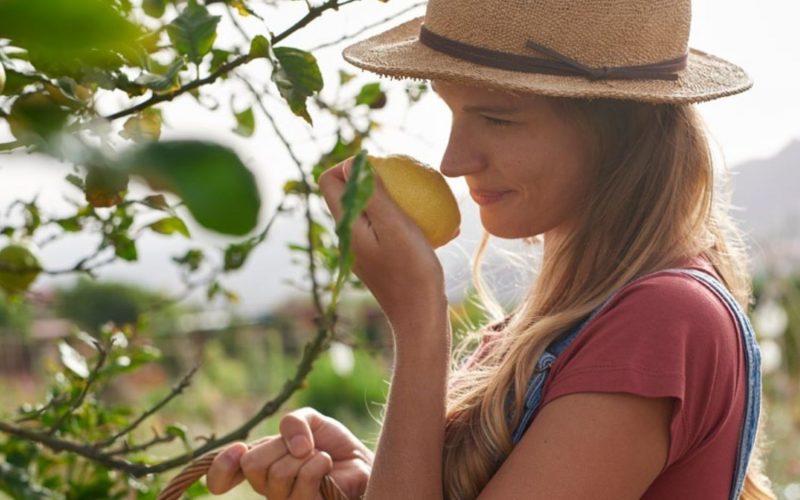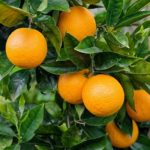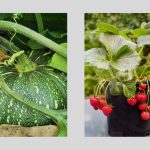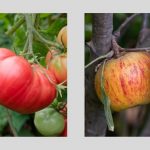Fruits are either climacteric, which continue to ripen post-harvest, or non-climacteric, which ripen only on the plant — and they should not be stored together.
Words & photos Angelo Eliades
As the growing season ends, fruiting crops may reach their full size but remain unripe, leaving gardeners uncertain about whether to harvest. Some crops can ripen after being picked, while others cannot — but knowing which is which can be a challenge.
By understanding which fruits, vegetables and berries fall into each category, and with some knowledge of the basic science of ripening, gardeners can make informed harvest decisions to maximise yield and avoid unnecessary effort on crops that won’t ripen further.
What happens during fruit ripening?
Botanically, fruiting crops — unlike root, stem or leaf crops — are plants cultivated for their edible fruits, which develop from the fertilised ovary of a flower and house seeds for reproduction.

These crops include fleshy fruits such as cucumbers and apples, true berries such as blueberries and tomatoes, and seed-bearing pods such as beans and peas.
In their early developmental stages, green, unripe fruits grow by accumulating water and nutrients. Once they reach sufficient size, the ripening process begins, marked by changes such as colour development, softening, conversion of starches into sugars and the enhancement of flavour and aroma.
These transformations make the fruit more palatable and nutritious for human consumption while also increasing its appeal to animals, which aids in seed dispersal and ensures the continuation of the plant’s lifecycle.
The two primary processes associated with fruit ripening are respiration and ethylene production.
Respiration is the metabolic process whereby fruits convert stored sugars and starches into energy, consuming oxygen and releasing carbon dioxide (CO2) and water. This energy drives the biochemical changes that alter colour, texture, flavour and aroma during ripening. The respiration rate differs across fruit types.

Ethylene (C2H4) is a gaseous plant hormone that plays a crucial role in initiating and regulating the ripening process in many fruits.
Fruiting crops are divided into two main categories: climacteric and non-climacteric, based on the differences in their ripening physiology, particularly how they mature and whether they produce ethylene gas to regulate the ripening process.
Ripening in climacteric fruits
Climacteric fruits are unique in that they can be harvested when mature but not fully ripe, continuing to ripen off the plant.
During ripening, their respiration rate and ethylene production rise significantly in the early stages before tapering off as ripening concludes.
These fruits produce ethylene gas, which accelerates respiration and hastens the ripening process. Ethylene also activates enzymes that
- degrade chlorophyll, changing the fruit’s colour
- break down cell walls to soften the texture, and
- convert organic acids and starches into sugars, enhancing sweetness.
This self-ripening ability is highly valuable commercially, allowing growers to harvest fruits while still firm and unripe, thus reducing bruising during transport and extending their storage life.
The fruits can then be artificially ripened with ethylene gas before being sold to consumers.
Examples of climacteric fruits include apples, apricots, avocados, bananas, blueberries, cherimoyas, figs, honeydew melons, kiwifruit, mangoes, nectarines, papaya, peaches, pears, persimmons, plums, quinces, rockmelons and tomatoes.
Climacteric fruits continue to ripen at room temperature, becoming sweeter and softer. Peaches, nectarines and plums taste best when juicy and soft, bananas when yellow with brown speckles and rockmelons when slightly soft.
However, these fruits must reach physiological maturity (not necessarily full size) to produce ethylene and ripen fully. For example, tomatoes harvested at the first visible signs of colour change, known as the breaker stage, can continue ripening indoors.
If climacteric fruits are harvested too early, their ability to produce and respond to ethylene is compromised, leading to incomplete ripening.
They may still soften or change colour to some extent but fail to develop proper flavour, texture or aroma, resulting in crunchy peaches, starchy bananas and bland tomatoes.
Harvesting at the right time is essential.

1. Allow strawberries to reach full ripeness for optimum flavour
2. Place bananas in a closed paper bag with some apples to ripen them indoors
3. Goldfinger bananas saved from early winter cold and ripened in the kitchen
4. Wait till the stems dry before harvesting pumpkins
5. Citrus are non-climacteric and need to ripen on the tree, but can remain there for weeks
6. The whole hand of green bananas can be cut when the sharp ridges become more rounded
Ripening in non-climacteric fruits
Non-climacteric fruits, in contrast, need to be left on the plant to ripen fully. Once removed, they won’t continue to mature, sweeten or improve in flavour as post-harvest changes are minimal.
During ripening, these fruits do not rely on ethylene to mature and their respiration rate remains steady or gradually declines during ripening.
Ripening in non-climacteric fruits depends on external factors such as temperature and light while the fruit remains attached to the plant.
These fruits typically ripen and mature simultaneously, so they must be harvested at peak ripeness for optimal quality. For example, pumpkins are ready for harvest when their stems are dry and hard and their skins lose their shine, signalling maturity.
Examples of non-climacteric fruits include blackberries, capsicums, cherries, chillies, citrus, cucumbers, eggplants, grapes, pineapples, pomegranates, pumpkins, raspberries, squash, strawberries, watermelons and zucchini.
Ethylene and its impact on crop storage
Understanding the ripening process is crucial to extending the storage life of produce and reducing food waste.
Climacteric fruits emit ethylene gas as they ripen, which can adversely affect ethylene-sensitive crops.
There are quite a few crops that are highly sensitive to ethylene exposure. These include asparagus, green beans, broccoli, Brussels sprouts, cabbages, capsicums, carrots, celery, chillies, cucumbers, eggplant, endives, leeks, lettuce, okra, peas (in pods), raspberries, spinach, squash and sweet potatoes.
When stored alongside high ethylene-producing crops such as apples, apricots, avocados, cherimoyas, nectarines, papaya, pears and ripe tomatoes, ethylene-sensitive produce is at risk of spoilage.
Damaged, bruised or punctured fruits release even greater amounts of ethylene, further accelerating the ripening and deterioration of ethylene-sensitive crops nearby.
For example, storing broccoli, kale, or spinach in the same refrigerator bin as apples can cause these vegetables to yellow and rot within a few days. Cabbage and Brussels sprouts may yellow, crack, or sprout prematurely, while carrots can develop a bitter taste due to ethylene-induced isocoumarin production.
Cucumbers also deteriorate more quickly in the presence of ethylene. Other ethylene-sensitive crops may deteriorate in different ways.
By understanding the physiological differences between climacteric and non-climacteric crops, gardeners can make informed decisions about harvesting and storage, ensuring optimal quality and yields while minimising waste and getting the most out of every harvest.








